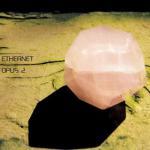
Ethernet Opus 2
(Kranky)
If you’ve ever read a puff-piece about the “I-Doser” fad, a pseudo-science of audio containing “binaural beats” designed to simulate the effects of drugs and emotions, you might be inclined towards cynicism when you learn that Tim Gray’s Ethernet project originated after he wrote an MFA thesis entitled “The Use Of Sound For Control, Healing and Empowerment”. Whether or not you buy into this idea of the therapeutic properties of sound, Opus 2 is a convincing exploration of the possibilities of ambience. Headphones are compulsory.
The six pieces on Opus 2 are lengthy, improvised sonic meditations using cloudy, ethereal digital tones. It’s always gently nudged along by a steady, minimalist beat, a ghost of a house tempo, not so much percussion as an insistent bump driving the music, even when you barely register it (it’s almost completely buried on the fuzzy Cubed Suns). It’s never enough to be propulsive, and sometimes one wishes that it did get more insistent – there’s the heady swells of Fuck Buttons or Emeralds somewhere in the haze, but Ethernet never really unleashes that potential, dwelling instead in ambience.
Gray engages more with harmony than on his debut, 144 Pulsations of Light, and in that respect it is a shade more compelling on repeated listens. Although it lacks the majesty of the subtle mood swings of peers like Tim Hecker, Philip Jeck, or Fennesz, the sense of exploration, and its consequent ambivalence, elevates it beyond an academic exercise in brainwaves and binaural beats. There’s a steady arc across the record, from the bright positivity of opener Monarch to the brooding darkness of closer Pleroma, and it tends to get more interesting as the tension builds.
A press release insists that Opus 2 is “intended to induce inner contemplation and internalized focus on the light within us”, whereas 144 Pulsations of Light was “about expansion of awareness and opening to the light that surrounds us”. Opus 2 does feel slightly more human, but perhaps mostly because it’s a development from 144 Pulsations, and was created with a greater emphasis on improvisation, more than a great difference in musical signs. This is perhaps more a matter of how to discuss music which is designed to be meditative, appealing to the subconscious – it eludes critical dissection.
It’s certainly possible to get lost in some of these textures – the thing is to stop it from being background music and turn it up – eventually the songs sound like great waves crashing into you, especially the deceptively turbulent Dog Star. It would be naïve to dismiss this idea of audial healing, new-agey as it might sound; this sense of meditation is the key to appreciating ambient music. But Opus 2 is first and foremost an immersive experience, and the academic questions about the subliminal properties of sound provide an interesting backdrop rather than its prerogative.
25 January, 2013 - 04:14 — Stephen Wragg